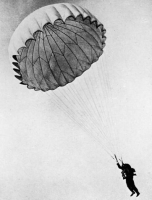








A parachute is a device used to slow the motion of an object through an atmosphere by creating drag, or in the case of ram-air parachutes, aerodynamic lift. Parachutes are usually made out of light, strong cloth, originally silk, now most commonly nylon. Depending on the situation, parachutes are used with a variety of loads, including people, food, equipment, space capsules, and bombs.
Drogue chutes are used to aid horizontal deceleration of a vehicle (a fixed-wing aircraft, or a drag racer), or to provide stability (certain types of light aircraft in distress,tandem free-fall).
The earliest evidence for the parachute dates back to the Renaissance period.The oldest parachute design appears in an anonymous manuscript from 1470s Renaissance Italy (British Museum Add. MSS 34,113, fol. 200v), showing a free-hanging man clutching a cross bar frame attached to a conical canopy.As a safety measure, four straps run from the ends of the rods to a waist belt. The design is a marked improvement over another folio (189v), which depicts a man trying to break the force of his fall by the means of two long cloth streamers fastened to two bars which he grips with his hands.Although the surface area of the parachute design appears to be too small to offer effective resistance to the friction of the air and the wooden base-frame is superfluous and potentially harmful, the revolutionary character of the new concept is obvious.
Shortly after, a more sophisticated parachute was sketched by the polymath Leonardo da Vinci in his Codex Atlanticus (fol. 381v) dated to ca. 1485.Here, the scale of the parachute is in a more favorable proportion to the weight of the jumper. Leonardo's canopy was held open by a square wooden frame, which alters the shape of the parachute from conical to pyramidal.It is not known whether the Italian inventor was influenced by the earlier design, but he may have learned about the idea through the intensive oral communication among artist-engineers of the time.The feasibility of Leonardo's pyramidal design was successfully tested in 2000 by Briton Adrian Nicholas and again in 2008 by Luigi Cani.According to the historian of technology Lynn White, these conical and pyramidal designs, much more elaborate than early artistic jumps with rigid parasols in Asia, mark the origin of ""the parachute as we know it.""
The Croatian inventor Fausto Veranzio (Faust Vran?i?) (1551–1617) examined da Vinci's parachute sketch, and set out to implement one of his own. He kept the square frame, but replaced the canopy with a bulging sail-like piece of cloth that he came to realize decelerates the fall more effectively.A now-famous depiction of a parachute that he dubbed Homo Volans (Flying Man), showing a man parachuting from a tower, presumably St Mark's Campanile in Venice, appeared in his book on mechanics, Machinae Novae (1615 or 1616), alongside a number of other devices and technical concepts.It was widely believed that in 1617, Vran?i?, then aged 65 and seriously ill, implemented his design and tested the parachute by jumping from St Mark's Campanile,from a bridge nearby,or from St Martin's Cathedral in Bratislava.In various publications it was falsely claimed that the event was documented some thirty years later by John Wilkins, founder and secretary of the Royal Society in London in his book Mathematical Magick or, the Wonders that may be Performed by Mechanical Geometry, published in London in 1648.However, in this book, John Wilkins wrote about flying, not about parachutes. He neither mentions Faust Vran?i? nor a parachute jump nor any event in 1617, and doubts about this test along with no written evidence of its occurrence, lead to the conclusion that it never occurred, and was caused by a misreading of historical notes.
According to other publications, the Chinese began parachuting as long ago as the 1100s, while modern skydiving began with Jacques Garnerin from France and his experiments and public demonstrations in 1797.